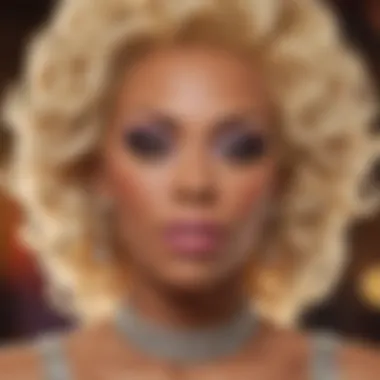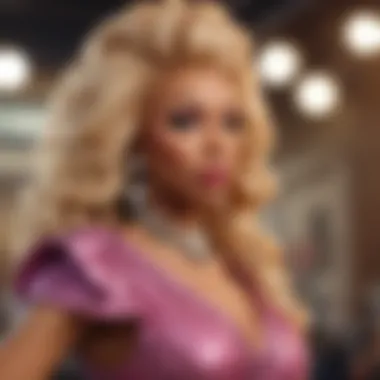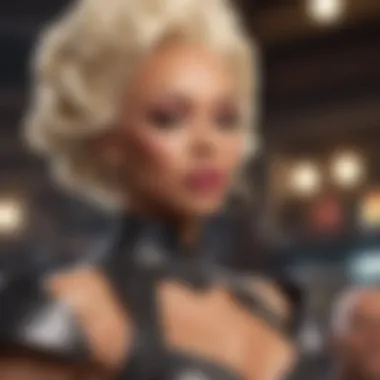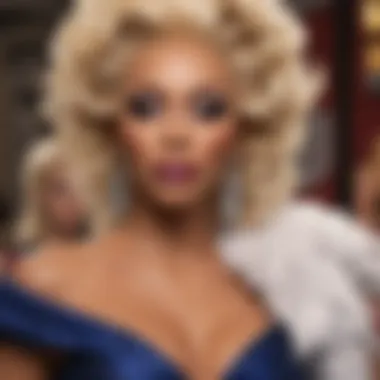Unpacking RuPaul's Drag Race Season 2: Cultural Impact & Legacy


Intro
The second season of RuPaul's Drag Race marked a pivotal moment in the landscape of reality television and drag culture. Delving deeper than the flamboyant costumes and competing queens, this season presented narratives of identity, resilience, and transformation. Each contestant brought their unique stories to the forefront, reflecting broader societal issues and challenges facing the LGBTQ+ community.
Throughout this analysis, we will explore key themes that defined the season. We will assess drag representation, understand the cultural impact, and engage with the moments that have solidified Season 2's legacy in the collective memory of its audience. From memorable performances to the evolution of drag strategies, this season altered perceptions and expanded discussions on diversity and authenticity in performance art.
Overview of Cinema/TV shows/Games/Comic Books
While RuPaul's Drag Race operates as a television show, it embodies elements that resonate with various forms of media including cinema and live performance. The interplay of visual storytelling, character arc development, and societal themes contribute to a cinematic experience that deepens engagement. Through a unique competition format, the show influences broader trends in entertainment.
Trends and Popularity
The impact of RuPaul's Drag Race can be traced through rising visibility for drag culture. Mainstream acceptance has increased since the release of Season 2. Key trends that emerged during this period demonstrate shifts in public perception and representation.
- Increased platforms for drag performers beyond just clubs.
- Transitions of some contestants into film and television.
- Growing interest in drag artistry among disparate demographics.
Releases and Announcements
The success of Season 2 laid groundwork for future seasons and spin-offs. Merchandise, music releases, and special episodes became intertwined with the show's branding. The cultural phenomena it spawned continue to shape modern entertainment dynamics.
In-Depth Analysis
Plot Summary and Analysis
In contrast to typical formats, the show merges competitions with real human stories. Each episode is structured around challenges designed to assess versatility, creativity, and performance skills. Through this competitive framework, contestants reveal deeper narratives, addressing personal struggles and triumphs through drag art.
Character Development
The contestants of Season 2 exhibited significant character evolution throughout their journey:
- Jujubee emerged as a fan favorite, showcasing resilience and humor, navigating trials with poise.
- Raven captured attention through her powerful performances, hinting at complex layers within her drag persona.
Setting and Cinematography
The production choices played a vital role in complimenting the storyline. Elaborate set designs, costumes, and dynamic camera work heightened the viewing experience. Intimate encounters excelled when simply shot. A focus on contestants rendered their narratives impactful.
Behind the Scenes
Insights from interviews shed light on the development process. Cast and crew described challenges seen in transforming raw stories into engaging television. The strategies they utilized shaped contestants and triggered new ideas.
“Behind every charismatically queens lies a story, and it is this divergence that enlivens the art of drag.” - a producer comment.
Production Insights
The production team navigates multiple directions, ensuring they focus on challenging situations while not exploiting emotional narratives. Interviews with contestants shed light on the support they found among peers amidst competition.
Reviews and Recommendations
Critic Reviews and Ratings
Critical reception was significant. Many praised the balance of high stakes and emotional narrative threads. Some episodes, however, received criticisms for pacing.
User Reviews and Comments
Fan responses echoed critical sentiments. Community platforms often fueled discussions related to memorable moments, insights that outperform mainstream judgment. Cheerful commentary emerged from fundamental reveal of unexpected outcomes, enhancing communal engagement.
Prelude to RuPaul's Drag Race


Overview of the Franchise
RuPaul's Drag Race stands as a cultural and artistic landmark since its inception in 2009. As a reality competition series, it showcases the artistry of drag, presenting queens who compete in a series of challenges to claim the title of America's Next Drag Superstar. The show not only captures the vibrancy and diversity within the drag community but also explores themes of self-expression, acceptance, and resilience. Over the seasons, the franchise has gained immense popularity and has expanded globally, influencing how drag is perceived in mainstream media. The series presents a platform where talents are celebrated, highlighting individual stories and establishing a community around the art form.
Moreover, RuPaul Charles, as both the host and a performer, has significantly shaped the narrative of drag in today's entertainment. His influence extends beyond the series, gaining attention within and beyond LGBTQ+ circles. The ability of the franchise to blend entertainment with meaningful dialogues around identity ensures its place in contemporary culture.
Significance of Season
The second season of RuPaul's Drag Race holds pivotal importance within the franchise. It is often viewed as a transformative season that solidified the show's format and appealed to wider audiences. Season 2 expanded the groundwork established by its predecessor. While the first season showcased the basic structure, season two introduced more complex challenges and provided richer character arcs for its contestants. Notable queens from this season, such as Tyra Sanchez and Raven, added depth, contributing uniquely to the show's narrative.
Beyond just these individual performances, season 2 brought forth discussions around serious topics like race, gender, and societal pressures. It steepened the audience's understanding of the diversity of drag representation. As the show progressed through its challenges and eliminations, it engaged viewers, increasing emotional investment in the various personalities.
Furthermore, viewers started to understand the balance between entertainment and reality in a competition setting. Season 2 served as a crucial touchstone that began to appeal to a larger subset of viewers, marking a significant increase in fan engagement and outreach.
The significance of RuPaul's Drag Race Season 2 cannot be understated. It highlighted not just the essence of drag artistry but strove toward broader societal themes and discussions in a digestible format.
Connecting these elements sets the stage for discussing the diverse phenomena that emerged during one of the formative seasons in the franchise’s history.
Cultural Context at the Time of Release
Understanding the cultural context during the time of Season 2's release gives important insights into its significance. Television is a mirror reflecting society's values, challenges, and changes. This season aired in 2009, a time ripe with discussions on LGBTQ+ rights and representation. The series itself became a key vehicle for drag culture to reach a broader audience, influencing perceptions and acceptance.
Drag in Mainstream Media
At the time of Season 2, drag was gaining sporadic visibility in mainstream media but had not yet fully integrated into popular culture. Shows had hinted at drag performances, but they remained fringe spectacles rather than central entertainment formats. RuPaul's Drag Race showcased drag not just as performance but as a form of art capable of conveying deeper messages.
It pushed boundaries and brought new audiences into the world of drag. Notably, with vibrant personalities like Tyra Sanchez and Raven, viewers were exposed to the creativity and diverse styles inherent in drag performances. This introduced a wide range of fashion, humour, and perspectives. The program acted as a catalyst; this visibility helped normalize discussions around gender fluidity and expression.
"By placing drag queens in the forefront, RuPaul's Drag Race changed what audiences perceived as entertaining and acceptable, introducing them to a compelling art form laden with history and significance."
LGBTQ+ Representation in Pop Culture
The landscape of gay representation in popular culture was evolving when Season 2 aired. Many media depictions were often stereotypical or troped. RuPaul's Drag Race broke that mold. It created a robust platform for LGBTQ+ voices, enabling drag queens to share their narratives while leading to deeper dialogues about identity and society.
This season contributed to wider societal changes, inspiring political discussions and rallies for LGBTQ+ rights. As more queens from diverse backgrounds competed, Season 2 served not only as entertainment but as a powerful statement against marginalization. Noteworthy was also the inclusion of conversations about themes like courage and authenticity within the community, expanding its impact beyond the TV screen.
In summary, the cultural context surrounding Season 2 was critical in cementing the show’s relevance. Drag Race provided a space where conversations could unfold, representing concepts of identity tied to societal attitudes. Its culturally rich content opened pathways to deeper understanding and appreciation, impacting both the media and LGBTQ+ initiatives.
Key Contestants and Personalities
The participants in Season 2 of RuPaul's Drag Race played a crucial role in defining the show's identity. They brought unique styles, stories, and perspectives to the competition, which appealed to a diverse audience. Understanding the contestants not only helps us appreciate their journeys but also reveals how their narratives reflect broader cultural themes. This section focuses on some of the notable queens and how RuPaul’s role as host and judge influenced the overall atmosphere and trajectory of the season.
Notable Queens of Season
Season 2 showcased a mix of charisma, uniqueness, and talent, seen profoundly in prominent figures such as Raven, Jujubee, and Pandora Boxx. Each contestant left an indelible mark on the season, enhancing the show's entertainment value while providing memorable moments.
Raven quickly became one of the standout queens due to her stunning looks and sharp wit. She captivated audiences and the judges with her thoughtful approach and fierce performances in challenges. Her rivalry with Jujubee showcased the depth and essence of healthy competition, establishing a compelling story arc throughout the season.
Jujubee, meanwhile, charmed audiences with both comedic timing and vulnerability. Her resilience and character allowed many viewers to connect with her personal narrative, making her a fan favorite. The dynamics between Jujubee and Raven illustrated how relationships could influence the progression of the competition, proving that collaboration and rivalry can coexist.
Pandora Boxx brought humor and creativity to challenges, making her one of the season's most memorable contestants. Her clever references to pop culture resonated with viewers, setting a high standard for uniqueness and imagination. Her ability to infuse humor without undermining the intensity of the competition highlighted the role of personality in engaging an audience.
In summary, the notable queens in Season 2 illuminate various aspects of drag culture while solidifying their places in fandom.
RuPaul's Role as Host and Judge


RuPaul’s presence in Season 2 was multifaceted; serving not only as the host but as a mentor and figure of authority. Her authoritative critiques guided contestants while also striving for a culture of support. RuPaul’s genuine assessment of the contestants provided valuable insights, encouraging personal and artistic growth.
As a judge, RuPaul balanced constructive feedback with encouragement. This allowed for a nurturing environment, where contestants could flourish creatively. Her charisma established a strong connection with both contestants and viewers, creating memorable moments during elimination ceremonies.
RuPaul also played a vital part in shaping challenges to reflect various aspects of drag performance. This foresight ensured that competition focused not only on visual appeal but also on performance elements that contribute to successful drag shows.
In addition, RuPaul embodied the evolution of drag as dynamic, showcasing how it combines elements of art, entertainment, and societal awareness. By highlighting the contestants’ growth and journey, RuPaul nurtured understanding about identity, acceptance, and individuality in the LGBTQ+ community.
Challenges and Performances
The realm of RuPaul's Drag Race is not merely a competition; it functions as an intricate examination of talent, artistry, and resilience often reinforced by fashion and humor. Challanges, alongside the breathtaking lip sync performances, provide the platform for contestants to showcase their unique brands and abilities. This section will focus on the significance of these components, highlighting how they not only shape contestants’ journeys but also elevate the show’s impact in the ongoing conversation surrounding drag culture.
Standout Challenges
Throughout Season 2, a myriad of challenges emerged that truly exemplified the essence and diversity of drag. These tasks were more than obstacles to overcome; they were curated experiences designed to amplify the queens’ creativity while also testing their skills.
One of the most prominent competitions was the Snatch Game, a parody of the classic game show where contestants impersonate celebrities. This challenge revealed not only comedic timing but also the depth of cultural references. Names like Victoria Beckham sprang forth from such impressions, showcasing an intersection of camp and wit. Many audiences found this particular episode engaging, as it offered glimpses into the strategic thinking behind each portrayal.
Another notable challenge involved creating original outfits from materials typically considered junk. Such creative expression pushed contestants to think outside conventional methods. The challenge dramatized judgements based on style while underlying a palpable tension between resourcefulness and aesthetics. This broader visual commentary transformed the performance level, redefining what constitutes 'drag.'
When evaluating these standout challenges, it is vital to appreciate their role in nourishing aspirations, pushing boundaries, and molding character arcs. They cultivated rivalries and alliances, allowing viewers to form emotional attachments to those showcased.
Memorable Lip Syncs and Performances
Lip sync performances serve as the climax of tension and creativity in Drag Race. They are moments of sheer spectacle where the stakes become visibly high. Season 2 delivered unforgettable emotional moments where queens fought for redemption, survival, and sometimes, a spot at the top.
One performance worth mentioning is the fierce showdown between Rebekah and Tyra Sanchez. This battle exemplified mastery over both lip syncing skills and stage presence. Each drag queen brought her individual story narratve into the performance, engaging the audience while conveying passion and urgency. The performance pulsated with energy and ended with cheers that resonated through the virtual screens of viewers.
Additionally, the popularity of lip sync battles helped redefine many contestants’ legacies post-show, contributing significantly to their careers both inside the Drag Race club and within the greater entertainment landscape. Contestants often feature these moments in their own promotional materials or tours, thus reaffirming the power of memorable lip syncs to captivate an audience.
"What sets RuPaul’s Drag Race apart is the combination of high art and the grit of individual stories represented on stage."
These moments remind us of the thematic layers behind brilliant performances, drawing in the anilamits of fans reconnecting with their identities while supporting the art form itself.
Controversial Moments
Controversial moments in reality television often create significant conversations around the content, shaping the audience's perception and engagement. RuPaul's Drag Race Season 2 is no exception, filled with both challenging eliminations and intense drama that highlighted the emotional stakes of the competition.
Eliminations and Drama
Eliminations serve as one of the most critical aspects of RuPaul's Drag Race. In Season 2, the choices made by judges often sparked debates among fans. For example, Chad Michaels was viewed as a front-runner who many believed should not have faced elimination when he did. The decision to send home prominent contestants puzzled both the fans and the queens, contributing to heightened discussions about fairness.
- Contestants like Texas and Nicole Paige Brooks also found themselves embroiled in drama surrounding the eliminations, demonstrating how subjective the judgments could be.
- The unpredictability in eliminations showcased not only the talents of the queens but also highlighted the emotional toll on contestants.
The impact of these moments cannot be overstated, as they often blend entertainment with stark reality, offering critical insights into the nature of competition.
Impact on Contestant Relationships
The competitive atmosphere of RuPaul's Drag Race presents a paradox: it can forge strong bonds while also fostering rivalries. In Season 2, the conflicts had lasting effects on relationships among contestants, affecting how contestants perceived each other both during and after the show.
Statements of unintentional tensions during the judging and elimination process showed how personalities could clash. For instance, when Tatiana found herself at odds with Jade, it became evident that the stakes of competition could lead to fractures in friendships.
- Issues that arose from critiques during challenges highlighted vulnerabilities among contestants.
- The show also sparked conversations about how drag artists interact with one another and the importance of mutual respect.
This blend of drama and camaraderie made Season 2 both relatable and engaging, creating a narrative that went beyond the competition itself. Fans often found themselves invested not just in who would win, but in how relationships among the queens would evolve each week.
"What we see is not just a fight for the crown; it's also a testament to how high-pressure situations can redefine relationships in any professional environment."


In summary, the controversial happenings of Season 2 have formed an essential part of its legacy. Not only did these moments shape individual journeys within the competition, they also Examined larger implications regarding human relationships in competitive spaces.
Viewer Reception and Legacy
The viewer reception and the legacy of RuPaul's Drag Race Season 2 reveals profound effects that extend beyond television. This season played a critical role in shaping discussions around drag culture and its place in popular media. By understanding the reception, we can see how the show not only entertained but also influenced perceptions of LGBTQ+ identities.
Critical Acclaim and Fan Base Growth
Season 2 garnered significant critical acclaim that contributed to the growth of its fan base. Critics acknowledged the show's ability to blend humor, drama, and heartfelt storytelling. Many reviews praised the originality and creativity displayed by the contestants. High-quality challenges and personal narratives resonated well with audiences.
The season's engaging content resulted in a swell of discussion on social platforms and forums. Fans took to Reddit and Facebook to voice their support for individual queens while sharing in-depth analyses of the episodes. Such community engagement fueled the show’s popularity, leading to increased viewership in subsequent seasons. Driven by enthusiastic fans, the overall cultural currency of the series rose dramatically.
Notable Takeaways:
- Creative Challenges: Critically viewed as some of the best yet.
- Diverse Contestants: Represented various facets of the LGBTQ+ community.
- Social Engagement: Marked substantial growth in online conversations and fan interactions.
Influence on Subsequent Seasons
RuPaul's Drag Race Season 2 set a precedent that influenced future adaptations and iterations of the show. The legacy of the season is evident in its production values, challenge format, and story arcs that later became essential components of the series. Contestant development received narrative depth never seen before, allowing for engaging viewer arcs.
This impact is revealed in how later seasons have emulated the high stakes established in Season 2. Challenges became increasingly intricate, often requiring emotional investment from contestants while showcasing their eclectic performances. The blend of competition with genuine moments shifted the standard for what fans would come to expect.
“RuPaul's Drag Race isn't just a show; it's a cultural phenomenon that shaped expectations for reality TV.”
Future iterations strived for and often surpassed the acclaim of Season 2 while solidifying the show’s position within popular culture. Not only did the format replicate, but also the essence of what it means to be a drag performer continued to evolve, giving credence to exploring social issues and representation even more.
As we analyze the viewer reception and legacy of this season, it stands out as a key pillar in the growth of drag culture on-screen and in everyday conversations. By championing inclusivity and creativity, Season 2 answers the call for representational spaces in media, richly contributing to a larger movement that resonates today.
The Evolution of Drag Culture Post-Season
The second season of RuPaul's Drag Race marked a crucial turning point for drag culture, both within the show and beyond it. The impact of this season resonates through multiple fac ets of the cultural landscape today. Its significance cannot be understated as it went beyond entertainment to shape a social movement. This evolution influences themes of inclusivity, acceptance, and representation globally.
Impact on Drag Performances Worldwide
After Season 2, the visibility of drag as a legitimate form of performance art increased significantly. Audiences around the world have appreciated drag shows in diverse venues, from community theatres to mainstream bars. The creative license exhibited by contestants inspired a new generation of performers to push boundaries.
Many queens, like Raven and Jujubee, have inspired those to embrace unique styles. The shared experiences visible on the show normalized aspects of drag. The foundation laid in this season encouraged performances to be both entertaining and technically proficient. Drag nights became manifestations of celebration instead of mere nightlife pursuits.
The style, artistry, and social commentary present in performances have transformed. Newer drag artists now mix humor. Often, performances feature social and political undertones reflecting broader societal changes. The Season 2 effects have remained in these ongoing developments, shown through increased online platforms displaying elaborate performances.
Emergence of New Drag Artists
Following Season 2, many new voices joined the drag community. The rise of platforms like Instagram and TikTok has drastically influenced how artists share their work. Drag culture no longer centers around nightclubs alone; artists leverage technology to reach wider audiences.
Several figures who began their careers post-Season 2 showcase what can blossom when creativity meets innovation. Artists like Bianca Del Rio and Katya Zamolodchikova emerged, fully integrating comedy and drag. This diversity of approach ensures the evolution within drag art remains relevant to contemporary audiences.
Moreover, inclusivity has expanded. Performers from different backgrounds engage with various subcultures, promoting a rich tapestry of talents within the community. Consequently, this era marks a significant increase in the variety of performances found in drag shows today.
"Drag is not just a performance; it's a dynamic art form, intertwined with times and cultural shifts."
With nicher drag forms continuing to emerge, it becomes clear that post-Season 2 marks a legacy beyond entertainment, inspiring cultural discourse and breaking boundaries throughout the global performance landscape.
End
The journey through Season 2 of RuPaul's Drag Race reveals profound implications for both drag culture and the larger world of entertainment. It is important to understand how this season acted as a pivotal moment in the landscape of reality TV, pushing boundaries and reshaping perceptions of identity and performance.
Reflections on Season 's Contribution to Entertainment
Season 2 plays a crucial role in establishing what we often consider the golden age of drag performance on television. Several important elements contribute to this conclusion:
- Representation of Diversity: The contestants embodied unique backgrounds and perspectives, showcasing a wide spectrum of drag styles. This helped to normalize different expressions of gender and sexuality.
- Cultural Commentary: The season didn't just entertain; it provided insightful commentary on subjects like acceptance, competition, and the struggles inherent in LGBTQ+ life. Such themes resonate still today.
- Set the Format: Many challenges introduced in this season set a precedent for future seasons. The focus on both performance and personality dynamics shaped how reality shows would approach competition.
- Fan Engagement: Season 2 solidified a loyal fan base that actively participated in discussions and content creation. This engagement further elevated the series within pop culture, drawing broader audiences.
“Through a legacy that spans cultures and genres, Season 2 achieved not merely success but resulted in a reshaping of perceptions within entertainment.”



